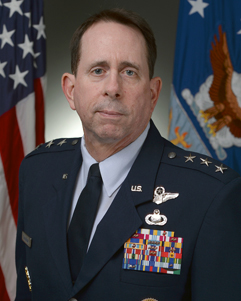The Pentagon’s Joint Artificial Intelligence Center has made development of warfighting capabilities its top priority over the next year, the organization’s leader said Thursday, following the award of its largest contract to date to Booz Allen Hamilton [BAH] for support on AI-enabled battlefield tools.
Air Force Lt. Gen. Jack Shanahan, director of JAIC, told attendees during an online AFCEA event the recent Joint Warfighting Operations task order will encompass projects such as smart sensors, cognitive assistance tools and AI and machine learning-powered systems for joint command and control.

“That is our big focus area for the next year,” Shanahan said. “It’s a big deal. This is showing that we are serious about taking AI and putting into warfighting operations.”
Shanahan said the five-year, $800 million task order to Booz Allen Hamilton, announced on Monday, signifies JAIC’s push to move projects out of research and development and toward rapid fielding of new capabilities across the department (Defense Daily, May 18).
“The next year will be about delivery for this organization. It will also be about Joint Warfighting Operations. We have to have the combatant commanders and the services knocking on our door saying, ‘We can’t afford you to go away. We need what you provide too desperately to cut you,’” Shanahan said.
JAIC is also continuing to push for its own acquisition authorities, according to Shanahan, who noted the recent task order was awarded using the General Services Administration’s $50 billion Alliant 2 contract vehicle.
“I don’t have them right now, so what that requires me to do is go out to places like DISA, DITCO, GSA, DIU for some of their OTA’s [and contracts]. We’ve pulled it off and it’s been okay,” Shanahan said. “But it’s not going to be fast enough as we start putting more and more into these capability developments. We need our own acquisition authority. We have to move faster.”
Shanahan said he has seen support on the Hill to assist JAIC in organizing unique acquisition authorities and models.
Projects under the Joint Warfighting Operations initiative will begin on lower-risk projects and look to use AI-enabled tools to accelerate sensor-to-shooter timelines and replace manual data processes with automated assistance tools.
“What do I mean by that, a call to fires. How do we take all this text and video and make use of that and accelerate that call to fires process. Or anything that is a manual, laborious process today, how do we accelerate that for the warfighter and in various tactical and operational centers,” Shanahan said.
While Booz Allen Hamilton will serve as a technology integrator for the project, Shanahan noted JAIC is currently working on outreach to get smaller non-traditional partners involved in supplying algorithmic tools and machine learning capabilities.
“Booz Allen is a prime integrator. They know how to work with the Department of Defense. They have security clearances, facility clearances. But our intent all along in the Joint Warfighting [initiative] is to have everybody still being a player in the development of these capabilities, everything from AI at the edge to targeting development, smart sensors” Shanahan said. “We’ve got a plan to do that. We’ve got a lot of outreach now. But we can do better.”